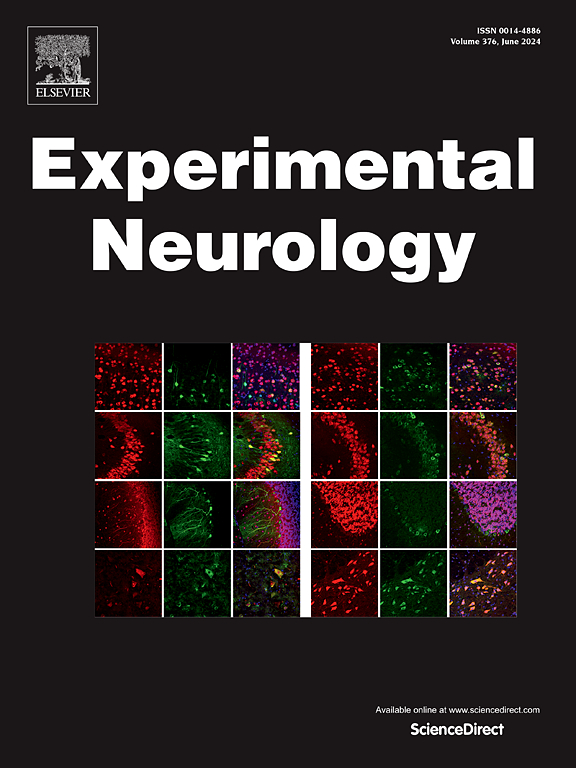帕金森病和2型糖尿病的分子研究:二甲双胍的作用和遗传途径的探索。
IF 4.6
2区 医学
Q1 NEUROSCIENCES
引用次数: 0
摘要
背景探讨帕金森病(PD)与2型糖尿病(T2DM)之间是否存在双向关系,研究其常见致病机制,筛选参与病理过程的相关基因,预测二甲双胍(Met)的潜在靶点,从而制定新的治疗策略。方法采用双样本孟德尔随机化(MR)分析PD与T2DM的相关性。在PD和T2DM数据集中发现的常见混杂基因进行GO和KEGG分析、PPI网络分析和Hub基因鉴定。采用qPCR方法验证T2DM合并PD动物模型中hub基因的表达。随后,分析二甲双胍是否能缓解T2DM加重PD的行为和病理表现。确定了二甲双胍与T2DM和PD靶点的交叉,并分析了核心靶点和信号通路。最后,对二甲双胍与核心蛋白进行分子对接分析,确定对接位点。结果通过MR分析,PD与T2DM呈正相关,两者互为因果关系。中心基因RAC1、TPM2、MGA和DENND3在T2DM合并PD的动物模型中上调。我们分析了与T2DM和PD交叉的Met靶点,分别发现了17个和21个交叉基因,它们参与了与氧化应激、免疫和炎症相关的各种途径。PPI分析鉴定出T2DM和PD的枢纽基因(MMP9、NCF1、CYCS、EIF4E、SOD2)和PD (GFAP、VIM、MOCOS、EIF1、TH、ACTA2、CDC42)。动物模型验证了这些基因和途径的表达。分子对接分析探索了Met在蛋白质上的结合位点,结合能越低,稳定性越好。结论本研究有助于深入了解PD与T2DM的共同发病机制,并为二甲双胍在该疾病中的作用提供了新的认识。本文章由计算机程序翻译,如有差异,请以英文原文为准。
Molecular insights into Parkinson's disease and type 2 diabetes mellitus: Metformin's role and genetic pathways explored
Background To explore whether there is a bidirectional relationship between Parkinson's disease (PD) and type 2 diabetes mellitus (T2DM), study the common pathogenic mechanisms, screen relevant genes involved in the pathological process, and predict the potential targets of metformin (Met), so as to develop new therapeutic strategies.
Method A two-sample Mendelian randomization (MR) analysis was conducted to analyze the correlation between PD and T2DM. Common confounding genes identified in both PD and T2DM datasets were subjected to GO and KEGG analysis, PPI network analysis, and Hub gene identification. qPCR was used to verify the expression of hub genes in an animal model of T2DM complicated with PD. Subsequently, the analysis focused on whether metformin alleviates the behavioral and pathological manifestations of PD aggravated by T2DM. The intersection of metformin with T2DM and PD targets was identified, and the core targets and signaling pathways were analyzed. Finally, molecular docking analysis was performed between metformin and core proteins to identify the docking sites.
Result Through MR analysis, a positive correlation between PD and T2DM was identified, indicating a mutual causal relationship. The hub genes RAC1, TPM2, MGA, and DENND3 are up-regulated in animal models of T2DM with PD. Met targets intersecting with T2DM and PD were analyzed, revealing 17 and 21 intersecting genes respectively, involved in various pathways related to oxidative stress, immune, and inflammation. PPI analysis identified hub genes for T2DM (MMP9, NCF1, CYCS, EIF4E, SOD2) and PD (GFAP, VIM, MOCOS, EIF1, TH, ACTA2, CDC42). Animal models validated the expression of these genes and pathways. Molecular docking analysis explored Met's binding sites on proteins, with lower binding energies indicating greater stability.
Conclusion This study contributes to a deeper understanding of the co pathogenesis of PD and T2DM, and provides new insights into the role of metformin in this disease.
求助全文
通过发布文献求助,成功后即可免费获取论文全文。
去求助
来源期刊

Experimental Neurology
医学-神经科学
CiteScore
10.10
自引率
3.80%
发文量
258
审稿时长
42 days
期刊介绍:
Experimental Neurology, a Journal of Neuroscience Research, publishes original research in neuroscience with a particular emphasis on novel findings in neural development, regeneration, plasticity and transplantation. The journal has focused on research concerning basic mechanisms underlying neurological disorders.
 求助内容:
求助内容: 应助结果提醒方式:
应助结果提醒方式:


